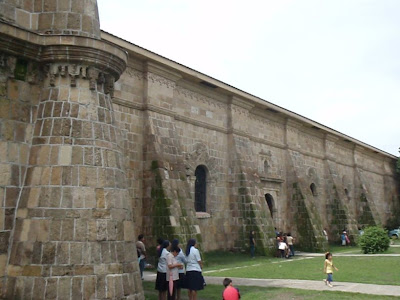One thing that attracted me to visit Iloilo is the presence of very old churches which are mostly within an hour's drive from each other. So after doing Guimaras last Saturday, kids and I embarked on a tour of some notable Iloilo churches the following day. We traveled about 70 minutes and 40km southwest by jeepney from our hotel to our farthest church destination.
We passed the scenic seaside towns of Villa, Arevalo, Oton, Tigbauan, Guimbal, then Miag-ao. If the kids are not with me, I might have traveled up to the last Iloilo town San Joaquin, along the boundary of Antique province.
We passed the scenic seaside towns of Villa, Arevalo, Oton, Tigbauan, Guimbal, then Miag-ao. If the kids are not with me, I might have traveled up to the last Iloilo town San Joaquin, along the boundary of Antique province.
I decided to start with one of their most famous churches -- the Santo Tomas de Villanueva church or more commonly known as Miag-ao church. It is one of the only 4 baroque churches in the country inscribed on UNESCO's World Heritage List, built between 1787-1797 by Augustinian friars.
One of its most interesting feature is its unique and well-preserved facade with deeply-incised relief carvings, giving it a nice three-dimensional view. The bas relief shows St. Christopher as a farmer carrying the child Jesus in reaching for the coconut tree. Papaya, guava trees, banana leaves, and other Philippine flora and fauna are also sculpted on the facade, although they are out of scale to emphasize the Filipino theme of the facade.
One of its most interesting feature is its unique and well-preserved facade with deeply-incised relief carvings, giving it a nice three-dimensional view. The bas relief shows St. Christopher as a farmer carrying the child Jesus in reaching for the coconut tree. Papaya, guava trees, banana leaves, and other Philippine flora and fauna are also sculpted on the facade, although they are out of scale to emphasize the Filipino theme of the facade.
Aside from being a church, it was also constructed to serve as a fortress where civilians can take refuge during raids by muslims and pirates of that time. As you can see from the photos, large contrafuertes or butresses were constructed on each side to further strengthen its 1.5-meter thick walls. The church have been destroyed and rebuilt after suffering the 1898 revolution, as well as the succeeding fires and earthquake. Good thing that we were able to hear part of their Sunday mass in Ilonggo when we arrived at this beautiful church.
Like most century-old churches in the country, this church was built using endemic stones, limestone, egg whites, and molasses as binder and hardener. Cement was not yet available that time. So what do they do with so many excess egg yolks? My theory is that they use the egg yolks in making broas and leche flan, hence the popularity of these local sweets.
Along the road enroute to Iloilo, we spotted this old Guimbal church below, while riding on a jeepney. It was built in 1774 using yellow stones called "igang".
Second stop is also an old church, the Parish of St. John of Sahagun in the town of Tigbauan. It was built in 1575 also by Augustinian friars, but have to be rebuilt after the1948 earthquake. Its facade has 3 belfries with Mexican-influenced design.
Upon entering the Tigbauan church's compound, we noticed a stall selling the Iloilo's version of ricecake which we tried. Unlike the ricecakes during Christmas time in Luzon, this ricecake has coconut strings mixed in the dough.
Third stop was the Santa Ana or Molo Church within Iloilo city, built in 1831 and has withstood earthquakes, but has to be rebuilt after its belfries were destroyed in Second World War. Our national hero Jose Rizal visited this church below due to its biblical paintings.
Its design is Gothic Renaissance with its pointed spires of its belfries, and is known as the feminine church due to the 16 images of female saints adorning its pillars.
See the old church bell fabricated in 1869, but was damaged during the war.
After lunch prior to passing the time at SM Mandurriao, we visited the Jaro Cathedral, built in 1850's with its unattached original belfry fronting it. One of our local heroes, Graciano Lopez Jaena was baptized here in 1856, before it was destroyed by the 1948 earthquake.
In contrast with Molo Church, this is known as the masculine church with images of male saints adorning its pillars.
And its solitary and separate belfry that acts as an island on the road, making the Jaro Cathedral quite unique among Iloilo's churches.

















Jeepney fare from Iloilo City to Miag-ao town plaza is P38. Jaro town is on the northern part of the city, near SM City Mandurriao when riding the airport vans at the mall's terminal.
ReplyDeleteYup Iloilo is churches galore. at least you've been to the more famous ones and that's quite a "haul". you even too ka bibingka side trip. sayang i wasn't able to tip you about a bingka near JARO CATHEDRAL which is among the most famous in Iloilo. Unliek the ones you got this one is very thin but it'll be one of the best ones you've tried if ever.
ReplyDeleteHope you enjyoed your trip
Sayang yung Jaro bibingka, but it gives me more reason to come back to Iloilo.
ReplyDeleteI forgot to add on my post that during long hauls, its customary to pay the jeepney fare to the conductor as the passenger is about to get off from the jeep.
Do you know any cluster of nice old churches in northern or eastern part of Iloilo, worthy of second visit to the province?
Thanks.